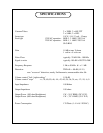
OPERATIONAL NOTES
SWITCHING ON
The power switch is located on the right hand corner of the front panel. Flip the switch up to
turn on the preamplifier and down to turn off the preamplifier.
RUNNING
It is not recommended that you leave your preamplifier permanently switched on. This only
wastes electricity and tube life. Your preamplifier has both tube and solid state rectification and
reaches peak operating condition in approximately 30 minutes.
TUBE LIFE
As with all tubes, their quality degrades with age. This is due to cathode emission, a natural
process found in all tubes. We recommend that you have your preamplifier checked every 4-5
years, depending on usage. An excessive increase in noise level can indicate the need to replace
a tube. A 300B is a long life tube.
REPLACING A TUBE OR LAMP. You may need a small Phillips screwdriver and a
replacement tube or lamp. First be sure the unit is off and remove the IEC mains cable. Let it sit
for 15 minutes to be sure all power supply capacitors are discharged otherwise one could still
get a shock even though the unit is unplugged. If you are changing a tube or lamp, be sure that it
the same number or is on the list of possible substutions. Gently wiggle the tube around while
pulling it out of the socket. Avoid bending the printed circuit board. Before putting a new tube
in, look at it. Check to see that the pins are straight and that they line up to the socket. You
should be able to gently push the tube into the socket without excessive force. If it is the
indicator lamp that needs replacing. Remove the bottom cover. Six screws near the sides hold it
in place - when these are removed, the cover should lift off. You will see what looks like a fuse
directly behind the black name panel. Gently pry the lamp out and replace it with another lamp
and not a fuse. Replace the cover before powering up the unit.
HUM This unit is meant to use the third pin of the mains as the ground reference. Many power
amps also use the third pin mains ground. Here we have a potential source of hum and what we
call ground loops. The solution is to use one of those grounds and only ONE. Use an 3 pin to 2
pin adapter for other equipment rather than breaking off a pin. Typically one power amp will be
grounded and all other 3 pin mains gear will have adapters. Sometimes the better option is to
ground the preamp and "float" the amps.
Another source of hum can be equipment stacked on top of one another. This is not a
good plan from the ventilation standpoint generally and it is likely to introduce hum, buzz or
noise into the system. Certain gear radiates magnetic fields or high frequency noise around its
chassis and other gear may be prone to receiving these fields. Distance helps greatly.














